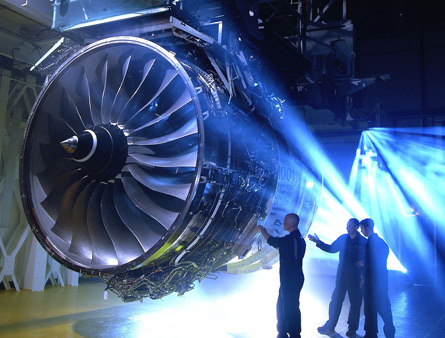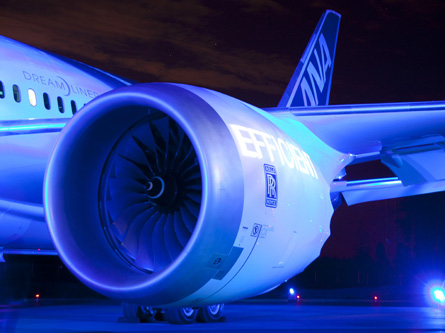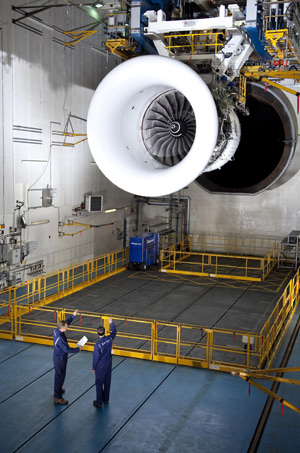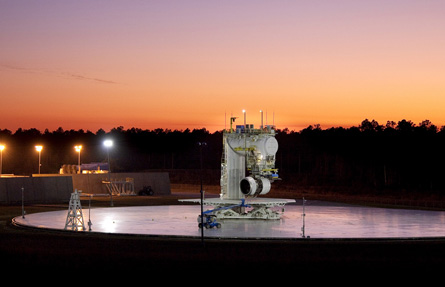Rolls-Royce may be losing its foothold in the high-volume narrowbody engine market, but when it comes to high-value big-twin powerplants the UK-based manufacturer is going from strength to strength.
Production of the Trent 1000 turbofan for the long-delayed Boeing 787 is finally on an upward curve after the aircraft entered service with launch customer All Nippon Airways. Meanwhile, Rolls-Royce's status as de facto sole-source engine supplier for the Airbus A350 XWB leaves it looking at its steepest ever production ramp-up for a new programme.
 |
|---|
| © Rolls-Royce Rolls-Royce builds about one Trent 100 a week |
Rolls-Royce is simultaneously investing in a suite of technologies that - if all goes to plan - will equip the next iteration of the three-shaft Trent in time for future widebody developments that could go into service around the end of the decade.
The Trent 1000 has already powered ANA's initial 787s on several hundred revenue flights, and the first long-range variant equipped with "Package B" engines began flights to Frankfurt in January.
"I suspect this is where you'll start to see some of the real benefits of the aeroplane, with the high humidity rates and the differences in cabin pressure," says Trent 1000 programme director Simon Carlisle. "It will be good to see that they start to get passenger differentiation at that point in time."
The first four ANA aircraft have Package A engines, which will be replaced with Package B units. "We had a lot of milestones last year for a project that's been fairly long in the tooth," says Carlisle. "We certified two engines, we cleared ETOPS, we did function and reliability [testing], we delivered the first aeroplane and we went into service."
In terms of development, Carlisle is focused on the 74,000lb-thrust (330kN) Package C Trent 1000 that will debut on board the stretched 787-9. The intention is that this will also become the standard powerplant for the baseline -8, allowing Rolls-Royce to maintain a common bill of materials to simplify production and support.
Further down the line, a further 787 stretch known as the -10X could become a reality. "We're still talking to Boeing and trying to understand what their plans for the -10X are, specifically in terms of size and timing, and they continue to be the key points of that discussion," says Carlisle. "We feel well placed because we have an engine that's capable of going up to 74k of thrust. It has more capability if required."
According to Boeing figures, the Package B engine is 2.3% better on fuel-burn than Package A, although B remains 2% off the Rolls-Royce specification. C is projected to be "just over 1% off spec" says Carlisle, but further technology insertion should get the engine back to specification.
"We are looking at putting some more technology in. We are doing some stuff with the LP turbine case cooling and changing some of the aerodynamics in the compressor. Not huge change packages, but some," says Carlisle.
The plan calls for certain improvements developed for the Trent XWB to be introduced on the 1000. "The thing that is very attractive to us is the [XWB's] high- and intermediate-pressure 'rising line' compressors," says Carlisle. "It's a good technology and it's easily transferable into the Trent 1000. Similarly, we've got a whole load of demonstrator programmes running that are churning out technologies that we are looking at."
FLEXIBLE TESTING
Although the Package C engine will enter service powering the 787-9, it will be flight-tested on the -8.
"What we were keen to do is not link the certification and qualification of an engine to a new airplane delivery. It would be bad for us if the -9 suddenly started to slip and we couldn't put a better engine on the -8 because it was linked to the -9," says Carlisle. "Boeing have exactly the same view, but their motivation is that by doing that they can offload some of the flight testing from the -9."
European Aviation Safety Agency approval of the Package C powerplant is targeted for the end of the first quarter of 2013. Entry into service with 787-9 launch customer Air New Zealand is scheduled for April 2014, and Rolls-Royce is now focused on achieving the required production-rate ramp-up after years of delays to the airframe programme.
 |
|---|
| © Rolls-Royce Trent 1000s have powered hundreds of revenue flights |
"It's early days," says Carlisle. "We've been changing the product, incorporating modifications. They all need to get flushed through and stabilised in the supply chain. We, like Boeing, have got improvements we need to make there to get to the point where we feel more confident about the rate at which we produce engines and the cadence with which we produce them on a routine basis. It's no different from other programmes.
"It's quite a shallow beach for the Trent 1000 on the 787. We have only ANA until, notionally, Q3 this year... There are about 12 aircraft to deliver, then we start to see LAN and LOT come on line. From my perspective, having a single operator to focus on with high-cyclic usage is a great learning position to be in."
The manufacturer is building about one Trent 1000 per week, which will increase to 1.5 at the end of 2012. The rate will further rise to two per week during 2013.
 |
|---|
| © Rolls-Royce First flight of the A350-900, powered by Trent 900XWBs is due in early 2013 |
Integration tests have been completed with engine 20002, the first to be equipped with the Goodrich-supplied thrust reverser, along with other accessories including variable-frequency generators and hydraulics.
This engine is now being reconfigured for the large flocking bird test, which involves ingestion of a single 4lb (2kg) bird. The medium test with four 2.5lb birds has already been completed. Another of the engines will be dedicated to achieving a continuous 500h of cyclic testing.
"This will give us a very robust and representative service-usage type of environment," says Trent XWB programme director Chris Young. "We also seed out-of-balance deliberately into all of the shaft systems on that engine, to simulate the worst case of vibration on to all of the units and externals to prove the robustness of the engine. It's a very good maturity test."
The first 150h endurance test using engine 20004 has been completed. "That was completely successful bar one minor finding," says Young. "We are rebuilding that engine to do a second endurance test where we're going to push to even hotter temperatures and higher speeds to clear the full service margins."
The discovery of a damaged "flying seal" after the first endurance test led Rolls-Royce to fix the problem on the flying testbed engine before first flight. The engine had to be removed from the A380 so the seal could be replaced.
"It was a very quick and easy change to make," says Young. "We had time and it gives us the right standard to go flying with. We've also put that new standard of part into the cyclic engine. That testing demonstrated that the part works well."
The nine-month A380 testbed campaign is expected to cover 175h flight hours across roughly 60 flights. "We've got 1,200 instrumentation parameters on this engine. It's going to give us great amounts of data," says Young.
Although Airbus has slipped the A350-900 development schedule by up to a year, Rolls-Royce has not felt the need to use that time to make further design changes. "We're not making any changes in our programme as a result of those Airbus movements, other than it gives us a little bit more time before we have to deliver the flight-test engines," says Young. "We may make some choices just to put some weight reduction in there and enhance the maturity of those engines. While we didn't need the extra time, we'll make good use of it."
For the first time on a new engine programme, Rolls-Royce has dedicated one engine to proving the build process, and later to repair and overhaul procedures. This engine was recently released into the pre-production process. First flight of the A350-900, powered by Trent XWBs rated at 84,0000lb thrust, is due in early-2013, followed by entry-into-service little more than a year later. The A350-800 EIS is set for mid-2016 and the larger -1000, powered by upgraded 97,000lb-thrust engines, in mid-2017.
Altitude testing of the latest Trent has proved compressor surge margins are sufficient at high altitude, after Rolls-Royce earlier decided to trade some surge margin for better efficiency.
"This testing has demonstrated that we can actually do a little bit more than that, because the surge margin has been so good on the compressor. Given the time we've now got, we can do this prior to entry into service," says Young. This will yield about another 0.1% specific fuel consumption improvement to add to the 0.25% already achieved through trading surge margin.
TESTING TIMETABLE
The first of 13 flight-compliance engines for the A350 test programme will enter the pre-production line in April, followed by the others at a rate of one per month.
The fan blade-off test is to be completed in Derby around mid-year. "We'll certificate some time towards the end of this year, most likely," says Young. "We don't need to certify before first flight [on the A380 testbed] so we'll certify when the engine is ready."
In terms of development, the focus for the XWB is now on finalising the configuration of the 97,000lb variant for the A350-1000, which will incorporate an increased-flow fan system and bigger core. "It's an important year for us to get the concept of the -1000 engine finalised," says Young. "It is increased investment and change for us, but we think it's the right thing to do for the life of the aircraft programme. We were doing the higher capability turbines, and that's where most of our technology programmes are around, but we've got some more work to do in terms of putting the increased flow into the core system.
"We haven't finalised our definite list of technologies, but we don't need to do that until around the middle of this year. My shopping list is more extensive than it was [before the Airbus decision to increase thrust requirement for the -1000]. That's what allows us to keep the SFC [specific fuel consumption] unchanged even though by making the core bigger the cycle gets a little bit worse. It's also given us time to drop the risk a little bit more on some of the technologies." Production of the first of six test engines for the -1000 is due to begin in the first quarter of 2014.
 |
|---|
| © Rolls-Royce Trent XWB engines have accrued 1,500 hours in ground tests |
Beyond work on the XWB, Rolls-Royce is stepping up its "Advance 3" studies of technologies that could be introduced into the next iteration of the three-shaft Trent, possibly around the end of the decade.
"The Trent XWB as it has been run today is the most fuel-efficient engine in the world," says Robert Nuttall, Rolls-Royce vice-president for strategic marketing. "That gives us a tremendous datum position. When we look at future products, we're starting from the very highest point in the industry."
The technologies under study would be applicable to a 90-100,000lb-thrust engine, with a fan diameter of about 130in (330cm), which Nuttall says is "getting towards the limits of transportability for trucks". Contemporary Trents have a bypass ratio of about 10 but this could be increased to 15, says Nuttall. Pressure ratios could climb to 60:1 versus 50:1 today.
"On the Trent we have delivered roughly 1% [fuel saving] per year over the life of that programme," he says. By the end of the decade that could mean a further reduction of 3-5%.
Composite fan blades are one example of a technology likely to reach maturity in the required timeframe. "Until now we would argue that Rolls-Royce has led the world in titanium fan blades - a blade technology that has been lighter than its composite competitor," says Nuttall. "If we can get a composite system - the blades and the fan case - then we can save a lot of weight, but up until now we haven't been able to get a composite blade that's as aerodynamically efficient as a titanium blade.
"It has been easier to make a thin, slim aerofoil with metal. We now believe we have managed to get a blade that is as efficient as our titanium blade but allows us to have a composite blade and containment system and altogether they will save us 500-1,000lb of weight. In context, that's an amazing amount of weight to save. The trick is how you lay-up the blade."
VORTEX AMPLIFIER
"Lean-burn" combustion, meanwhile, has been tried before but has failed to live up to expectations in airline service because of reliability and weight problems. "The science is relatively straightforward, but getting this to be a reliable, controllable system in a real-world operation in an airline is not straightforward," says Nuttall. Rolls-Royce plans to fly a demonstrator in 2014, which it believes will address these issues.
The "Enables" concept, meanwhile, embeds electrical connectors in composite material to replace external cabling that can get damaged and is hard to repair. It also promises a weight saving of 50-150lb, depending on engine size. "Redundancy is built in, so that if something happens to one of the connective links, another one takes over," says Nuttall.
Also in train are efforts to mature new materials that increase the temperature capability of the core, enabling it to be reduced in size. "High temperature takes you to ceramics," says Nuttall. "We're busy working on that."
The "vortex amplifier" aims to simplify the process by which turbine blades can be cooled by extracting air from the high-pressure compressor (HPC). Air is bled from the HPC, routed around the combustor and put into the turbine, increasing the engine's fuel consumption. "In an ideal world we'd like to modulate that, and turn it down when you don't need as much," says Nuttall, who labels the vortex amplifier an "air transistor". He adds: "An air signal creates a vortex in the flow which controls how much of the cooling air goes across the chamber. It's an 'amplifier' so we can modulate the flow with no moving parts. We set up the vortex with a very small injection of air."
The overall efficiency gain is "much less than 1%, but they all add up", says Nuttall.
Source: Flight International
















